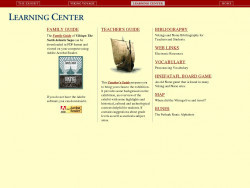Kate Harris
Social Studies teacher
Pittsburgh CAPA
Middle School (13 to 15 years old), High School (16 to 18 years old)
Teacher/Educator
Language Arts And English, Civics, Literature, Cultures, Economics, Social Studies, Geography, Writing, US History, Arts, Other
I'm a history-lover, art fan, and bookworm. I taught high school history (U.S. History and World Religions) for ten years in North Carolina, teach currently in Pittsburgh, PA, and am working to help teachers make the most of this new resource!
Kate Harris's collections
World War II Lesson Plans and Interactives
<p>Collection of lesson plans and interactive websites related to World War II from the Smithsonian Institution.</p>
 Kate Harris
Kate Harris
13
Fighting World War II at Home
<p>Preparing for World War II in the United States meant uniting the nation and encouraging citizens to support the war with their actions and funds. However, it also created divisions within the nations, as Japanese-Americans were interned, African-American soldiers were segregated, and Mexican workers recruited to help with war-time demands were discriminated against. This collection includes objects reflecting a variety of aspects of homefront life during World War II and works well as an independent activity for students to complete. </p>
<p>Guiding questions for discussion before and after include:</p>
<p><strong>-In what ways did World War II unite the nation? In what ways did it divide the nation?</strong></p>
<p>-What new opportunities were created by the need for more workers in World War II?</p>
<p>-How and why did government regulation of the economy increase during World War II?</p>
<p>-Why do you think the examples of propaganda in this collection were so effective?</p>
 Kate Harris
Kate Harris
26
The Middle Ages: Discover the Story
This collection includes objects and artifacts representing life in the Middle Ages. Students are challenged to write a creative story or narrative based on the objects in the collection, illustrating life at the time. The last two resources in the collection are a worksheet that teachers may use to frame the assignment and a grading rubric for the assignment.
 Kate Harris
Kate Harris
12
Vikings--Myths and Mysteries
<p>The Vikings have inspired many artists, writers, and filmmakers with their bravery and unique way of life. However, many misconceptions have developed and many facts are still unknown. In this collection, students will explore the website for the Vikings exhibit while taking notes on the included worksheet. Then, they'll evaluate three works of art (and a team logo) based on the Vikings to gauge how accurately they represent Viking life. Finally, they will be asked to create their own 2-D or 3-D object representing Viking life.</p><p>Tags: Norse, inquiry, Viking, Norway, Greenland, Iceland</p>
 Kate Harris
Kate Harris
7
Pittsburgh 1932
This is a collection of images and documents that give historical context for the poem "Pittsburgh 1932." The poem itself tracks a city's changing economic landscape during war years and the Great Depression.
Students can use this collection directly to explore the literature and history.
 Kate Harris
Kate Harris
25
Practice Reading Portraits--Black History Month
<p>This collection was created for a brief warm-up activity where students practiced analyzing portraits of recognizable figures as a group, prior to working on their own portrait analysis. Portraits of Muhammad Ali, Serena Williams, Rosa Parks, and Booker T. Washington are included and they vary in detail and medium. </p><p>The last resource, a PDF file, is a teacher's guide created by the National Portrait Gallery. Teachers should lead discussion about the portraits using suggested questions in the guide, and then let students search for a portrait of someone of their own choosing to analyze.</p><p>tags: civil rights, sports, tennis, boxing, African-American, black history, analysis, comparison</p>
 Kate Harris
Kate Harris
6
The March on Washington
The Civil Rights Movement of the 1950s and 60s tackled many problems facing African-Americans at the time. This collection offers a brief video introduction into the March on Washington in 1963, which brought national attention to many of these issues, and asks students to analyze a photograph and three artifacts from the March. Students will answer the question "What problems did participants in the March on Washington aim to solve?" and consider how these issues continue to have relevance in the United States today.
tags: Civil Rights, Martin Luther King, A. Phillip Randolph
 Kate Harris
Kate Harris
6
Booker T. Washington and the Tuskegee Institute
<p>This collection includes photographs and paintings that reveal information about Booker T. Washington's strategy for achieving civil rights for African-Americans, and about the subjects taught at Tuskegee. It is intended as an introductory activity on the subject, to be completed by students.</p><p>Tags: point of view, Reconstruction, Tuskegee Institute, civil rights, segregation, Gilded Age, cause effect</p>
 Kate Harris
Kate Harris
5
Powerful Symbols and Words: Abolitionism & Women's Rights
<p>This collection looks at an image and phrase used widely in abolitionist materials, and at how that symbol was adopted and adapted by Sojourner Truth and/or other women's rights activists. Students will examine an abolitionist medallion and then learn about Sojourner Truth through a short reading, image analysis, and video. They can then review two version's of Sojourner Truth's speech and consider why the second version, as reported by another suffragette, Frances Gage, is markedly different. This collection is designed to be used as a short stand-alone lesson on the topic of the abolition movement and its intersection with the women's movement in the United States.</p><p>Tags: compare and contrast, change over time, "Ain't I a Woman?", abolition, slavery</p>
 Kate Harris
Kate Harris
4
Great Ideas, Modern Art, and Advertising
This collection consists of advertisements created for the Container Corporation of America in the 1950s. Each advertisement pairs a quote from a "Great Idea of Western Man" with a work of original art. After reviewing the collection, students will create their own art work to reflect a "Great Idea" that they think is important and meaningful in the world today.
 Kate Harris
Kate Harris
11
The Ancient Greeks Live On
A collection of artifacts showing how the ancient Greeks have influenced the modern world, combining both ancient Greek artifacts and modern objects and images. In some cases, the collection is incomplete and more modern examples could be identified. This is noted with some text and questions. Teachers might review this presentation with students, challenging them to identify modern examples that connect with the ancient objects that they see. Teachers are encouraged to ask students to compare and contrast, noting how time has changed certain concepts or ideas (e.g. our democracy is far more inclusive than Greek democracy was, although we use a representative democracy, not a true democracy.) Finally, teachers might consider using this activity as a precursor to further research on a specific topic addressing how the ancient Greeks continue to influence the modern world. Useful after students have had some introduction to the history and culture of Greece.
 Kate Harris
Kate Harris
29
Exploring American Ideals in Art
<p>How can American ideals be defined and expressed in different ways? The United States of America is associated the ideals of Democracy, Rights, Liberty, Opportunity, and Equality. Those values have served as sources of inspiration for artists as goals that the nation aspires to (even if they are not always achieved). This collection contains artworks inspired by one or more of the ideals listed above. Students should choose a work and identify which ideal it relates to: Democracy, Rights, Liberty, Opportunity, and Equality. </p><p>In a short essay based on the artwork, students should answer the following questions:</p><p>-How would the student define Democracy, Rights, Liberty, Opportunity, or Equality?</p><p>-What is the artist trying to communicate about how this idea plays out in America?</p><p>-Does the student agree or disagree with the artist's interpretation?</p><p>If desired, students could create their own artwork based on one of the American ideals.</p>
 Kate Harris
Kate Harris
21









